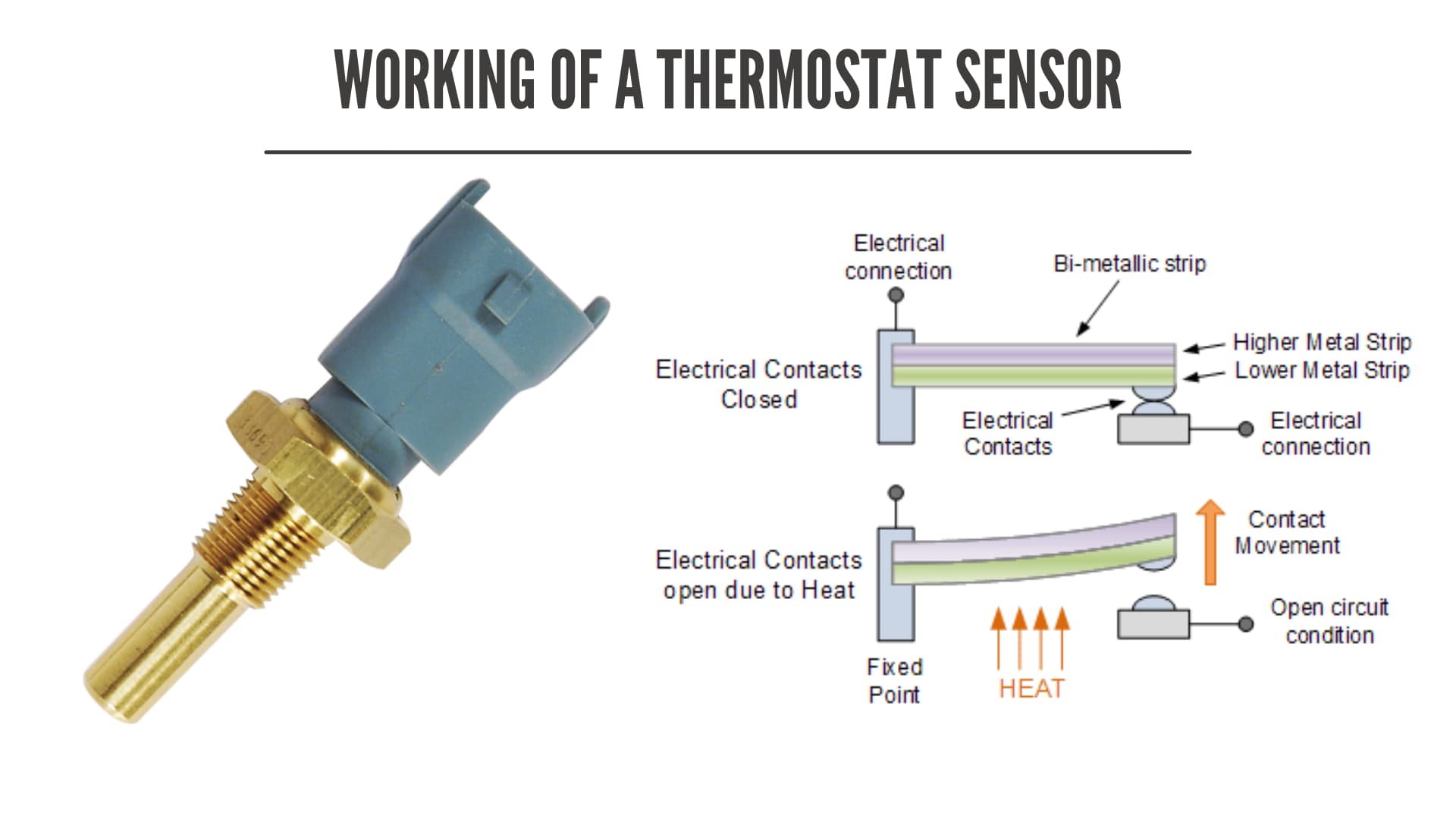When I first started with electronics creating a temperature sensor-based monitoring system was one of my first projects.
When I took the project, it was like a wake-up call.
I was so confident of whatever it is that has been taught to me in the class that I will be able to create the project without any problem.
But how wrong I was. Yes, I completed the project alright, but in the process, I learned a very important lesson.
When working with electronics never assume you know something just because you think you know how it works. Practicality is the name of the game.
Thermostats in technological terms can be talked off in two different contexts. In this article, I will be covering both of those contexts and provide you with the required clarity.
So, Is thermostat a sensor?
In the context of practical electronics, yes, a thermostat is a contact-type temperature sensor. On the other hand, a thermostat may also refer to a full-fledged temperature monitoring and control system when smart gadgets are the topic of discussion.
Now, at this juncture, it is very important for you to know the exact differences between the two.
In the subsequent sections let us do just that. Additionally, I will also share some of my experiences with practical electronics that will help you, if you as I am hoping you would if you work with sensors.
Here are a few more readings that will append your understanding of thermostats and electronics
- 7 best thermostats that work with alexa
- Do smart thermostats work without wifi?
- Do Arduino sensors work with raspberry pi?
- 7 best ring compaticle thermostats
- Send sensor data from arduino to raspberry pi!
What are Sensors?
Now, what exactly are sensors.
Well, let’s understand it like this, if it weren’t for sensors, you wouldn’t be able to able to read this article.
Let us assume you are reading this article on a laptop.
Your laptop comprises of different types of sensors that are continuously measuring physical parameters like temperature, fan rpm, etc., and sending the responses to a control unit thereby ensuring that the laptop performs in an optimal way.
I don’t know if this has ever happened to you. But if you play very graphically intensive games and if the laptop CPU temperature goes beyond a safe limit your laptop/PC automatically shuts off to prevent any serious damage to the sensitive components.
So, sensors are these physical devices that undergo a change in response to a changing physical parameter and produce an output signal.
Another definition that will resonate with you if you have some experience in the electronics domain is, sensors are devices that convert signals from pure physical domain to the electrical domain.
Let’s understand this with the help of an example.
I am pretty sure you have heard the term LDR. LDR is short for Light Dependent Resistor and it does exactly what its name suggests.
LDR undergoes a change in resistance depending upon the intensity of light that falls upon it.
More light falling upon the resistor will mean less resistance offered by the sensor to electrical flow. Similarly, if the intensity of light falling upon the resistor is less, LDR offers a lot of resistance to the electrical flow.
Because we are talking in context to temperature sensors, let me also give you the example of the sensor I used in my first project called LM35.
LM35 is an analog sensor whose voltage output changes linearly with respect to the temperature it is subjected to.
The change in physical parameters is then provided to circuitry that amplifies, filters, and converts the signal from analog to digital which then can be used to drive another circuitry or even control the conditions of which the sensor is a part of.
Thermostat in Context to Electronics
I said this at the beginning of the article that when using the term thermostat, there are two directions the understanding can progress,
And it will depend upon the context. When talking in terms of practical electronics, thermostats mean something different and if the discussion underway is around smart gadgets, thermostats mean something else.
So, what are thermostats in context to electronics?
In practical electronics, a thermostat is a temperature sensor that contains a bimetallic strip. When subjected to elevated temperatures the two metals expand differently and this property of different rates of expansions is made use of in sensing temperature changes.
Now there are many different types of temperature sensors when it comes to practical electronics. We are going to touch upon them in an upcoming section, but out of the thermostat is one.
Here is what a thermostat sensor looks like.

Structurally the probe contains two metallic-strip fused together as shown. Thermostats are usually referred to as electro-mechanical temperature switches.
These aren’t the type of sensors that provide you with a linear output that varies with the temperature they are subjected to. So that is why thermostat sensors are often referred to as temperature switches.
Thermostats are very mechanical in nature and therefore, are extensively used as electrical switches in thermostatic ecosystems like furnaces, hot water storage tanks, and vehicle radiator systems.
Thermostat in Context to Gadgets
Now if you are not involved in practical electronics, there is a good chance you may have first heard of a thermostat when researching smart gadgets.
Because both of the use cases involve the common domain of temperature measurement, you may find topics and conversations where one may mean the other and vice versa but in most cases, it won’t.
And therefore, it is imperative that you know the difference between both.
So, what are thermostats in context to gadgets?
A thermostat is a temperature monitoring and regulating subsystem that is capable of maintaining the temperature of an area near a desired setpoint. Thermostats are now capable of voice control and conserving energy and therefore, fall under the category of smart gadgets.
Here on Yantraas, I have created so many articles revolving around the use of thermostats and different aspects related to them.
One thing I can say for certain, they are evolving. Manufacturers are making it a point to incorporate advanced technological features like energy-saving mode, voice control, and compatibility with ring devices.
Most of this is of course driven by customer demands but the features can also be attributed to the natural progression of technology.
So, how do smart thermostats work?
Well, the smart thermostats have a common feature with thermostat sensors and that is sensing of temperature.
With thermostat sensors, you have the creative freedom to use this sensing the way you like. For instance, to switch off or on a circuit to send the generated signal to a different circuit to drive operations like motor control or system shut down.
A smart thermostat is a controlling and regulatory unit in the sense that it uses the temperature sensing capacity to ensure that the ecosystem it is part of has a temperature value that is already set or sensed depending on the environment.
But this is just a simplistic explanation of what these smart thermostats are capable of.
Regular thermostats are controlled using a dial or remote via which you can set the room temperature the way you want.
With smart thermostats, you get a more efficient, accessible, and user-friendly approach to do the same things and more.
The smart thermostat works in conjunction with your heating system, the main control, and an app that you can download on your favorite smart device. You can control and adjust the temperature using this app even when you are away.
Some smart thermostats can even learn the schedule based on your behavior and thus can automatically turn off or adjust the temperature depending upon these variables.
Is thermistor a sensor?
Another important term that I feel can be discussed around the context is what is known as the thermistor.
Because all of these terms are so closely related and perform similar functions, I just want you to not be confused when referring to each one of these.
So, what exactly are thermistors?
Thermistors are temperature sensors too, and what makes them different is that they have negative temperature coefficients meaning for a small changes in temperature they undergo a large decrease in their resistance.
Thermistors aren’t used with extreme temperatures, but for small to moderate temperature setups (around 50°C), they produce results with excellent precision.
They are relatively cheap, durable, and excellent sensors if you are learning how to interface sensors with something like an Arduino as a beginner.
As I said, thermistors usually have a Negative Temperature Coefficient (NTC), but that is not always the case.
There are thermistors with Positive Temperature Coefficients (PTC) as well, meaning their resistance increases as the temperature increases.
Thermistors are non-linear temperature sensors, how fast or slow the rate of resistance change would be (with changing temperatures) will depend upon the material used for its construction.
When it comes to applications, thermistors are commonly used in digital thermometers, in automobiles to measure oil and coolant temperatures, home appliances, and in-sensitive circuits that aid in heating and cooling protection.
Other Types of Temperature Sensor
So, we have looked at what thermostats are and what thermistors are, but those aren’t the only temperature sensors out there.
You see, the spectrum of temperature range varies from extreme freezing conditions to over-the-top heating ecosystems like a furnace or the gas exhaust of a rocket.
For obvious reasons, you cannot have a common temperature measurement mechanism for the entire spectrum.
And for that reason, there is a myriad of temperature sensors that are suitable for different situations. And that isn’t the only reason behind the different types of temperature sensors.
You see sometimes you may just want an electromechanical switch that turns the circuit on or off based on a very specific temperature.
In other cases, you may want very precise temperature measurement and in a completely different scenario, you may want the temperature values in bulk, where there is relative ease in precision.
So, use cases play a major role too in determining what kind of sensor is required.
Here is a quick run-through of the most common sensors that you will come across should you choose to delve deeper into practical electronics.
Resistive Temperature Detectors
The concept behind the working of these types of sensors is the fact that with a change in temperature the resistance of the element changes.
The elements that are chosen to create RTDs are those that have a very well-defined resistance vs temperature graph.
You want a material whose resistance changes very predictably with temperature or else your measurement won’t be as accurate.
Platinum is one of the most common elements that is used in the construction of RTDs.
Thermocouples
Thermocouples are the most widely used type of temperature sensor. They find applications in consumer devices, industrial and automotive applications.
The reason why these types of sensors are so common is that they are sensitive, have quick response times, are self-powered, and operate over a wide range of temperatures.
Their core operating principle is based on what is called Seebeck Effect. The effect describes a phenomenon that whenever there is a temperature difference between two dissimilar conductors there is a proportional voltage involved.
This voltage can then be conditioned to predict the temperatures.
Infrared Sensors
These are non-contact type sensors and are used to measure extreme temperatures where the contact of a sensor with the heated body is not possible.
Owing to the ease they offer; these types of sensors are now deployed in handy temperature measuring instruments too.
This infrared temperature gun from fluke can measure temperatures from -40°C to 800°C.
- Dual infrared and thermocouple thermometer for noncontact or contact temperature measurement in electrical maintenance and monitoring industrial and manufacturing processes
- Measures temperature with the infrared sensor from -40 to +800 degrees C (-40 to +1472 degrees F) with an accuracy of + or - 1 degree C (+ or - 2 degrees F)
- Measures temperature with the included Type K bead thermocouple from -40 to +260 degrees C (-40 to +500 degrees F)
- 50:1 infrared distance-to-spot ratio with laser sighting for pinpointing the measurement area
- Stores up to 99 points of data for analysis and monitoring on a computer
Semiconductor Sensors
Semiconductor temperature sensors are usually incorporated into ICs. They use a very specific type of diode arrangement that offers relatively linear voltage vs current characteristics.
While they are very convenient to use and deploy in electronic circuits they are known to offer very low accuracy. Additionally, their operating range is limited (-70 °C to 150 °C) and their response is slow.
In Conclusion,
To be honest with you, I have shared quite a bit regarding sensors here in this article, but I also know for a fact that I have just touched the tip of the iceberg so to speak.
There is so much more I can share with you here, but as far as the context of the article is concerned, adding more details won’t add to the value that you will get out of the article.
That being said, if you wish to know more about any topic that you came across in this article, just head to the search box and I am pretty sure you will get many informative articles around any doubts you may have.
For the things that I know I need to talk about more, I will make it a point to create a separate article for each of those.
Still, if there is something that you wish to know about, regarding this article or any tech topic in general, just let me know in the comments section below.
Take care of yourselves and I will see you around.




